Fives: Fives, sometimes called Five Cards, is a card game with gameplay
somewhat similar to Hazari. Fives is designed for 2 to 5 players and uses one standard 52 card deck. The ranking of the cards in this deck are as follows (from highest to lowest): King, Queen, Jack, 10, 9, 8, 7, 6, 5, 4, 3, 2, Ace.
Determination of seating positions and first dealer can be performed using a variety of methods, with draw for high cards very common. Using this method, each player draws a card from the shuffled deck. The players then take their preference of seats, from highest card drawn to lowest. If two or more players draw cards of the same rank, those players should discard those cards and draw new cards, continuing, if necessary until drawing a distinctly ranked card. The player drawing the highest ranked card of all is set as the first dealer, and after each hand, the role of dealer rotates around the table in a clockwise rotation.
The dealer begins the hand by thoroughly shuffling the deck and offering it to the player at his right for the cut. After the cut, the dealer begins distributing the cards around the table, one-by-one and face-down. He starts with the player at his immediate left and continues the deal until each player has a total of five cards. He then places the remainder of the deck face-down in the center of the table as the draw pile.
The player to the immediate left of the dealer has the first turn. This
individual thus examines his hand and decides how many, if any, of his cards he would prefer to exchange for new cards from the top of the stock. He thus removes any number of cards from his hand, placing them face-down, adding them to the bottom of the stock. He then takes a similar number of cards from the stock pile to replenish his hand to five total cards. This continues with each player, in a clockwise rotation around the table, having one opportunity to thus attempt to improve their hand with an exchange of zero to five cards.
After each player has had a turn to exchange cards as preferred, every player then places their hand face-up on the table in front of themselves. The hands are then compared and whichever player has the highest ranked hand is thus set as the winner of the hand, earning a number of accumulated points based on the cards in his hand. The other players earn zero points on that hand, regardless of the cards found in their hand. The following chart shows the possible hands and their ranking (highest from top to bottom), as well as the number of points a player would earn for that hand:
| Ranking | Hand | Description | Point Value |
|---|
| 1 | Four of a Kind | The highest ranked hand is a four of a kind. If multiple players have such a hand, these hands would then further be ranked by the denomination of the cards forming the four of a kind. | 8 Points |
| 2 | Full House | This hand consists of three cards of the same rank, and a pair of two cards in the same rank. If two or more players have such a hand, the hands can be further ranked by the denomination of the cards forming the triplet (three of a kind). | 6 Points |
| 3 | Treble | A treble consists of three cards of the exact same rank. If multiple players have a three of a kind, these hands can be further ranked based on the denomination of the cards forming the treble. | 4 Points |
| 4 | Two Pairs | This hand consists of two cards of the same denomination, and another two cards of a matching denomination. If there are multiple players with this hand, the denomination of the cards in the highest pair are compared. If this is an identical pair, the denomination of the second pair is compared. If this is also equal, the odd card is compared. | 3 Points |
| 5 | One Pair | This hand consists of two cards of the same denomination. The other three cards in the hand are unmatched. If comparing two such similar hands, the higher hand is that containing the pair which consists of higher denomination cards. If the pairs are identical, the hands are compared by whichever player has the highest odd card in the hand. | 2 Points |
| 6 | Junk | A junk hand is a hand with no matching cards. | 0 Points |
|
|
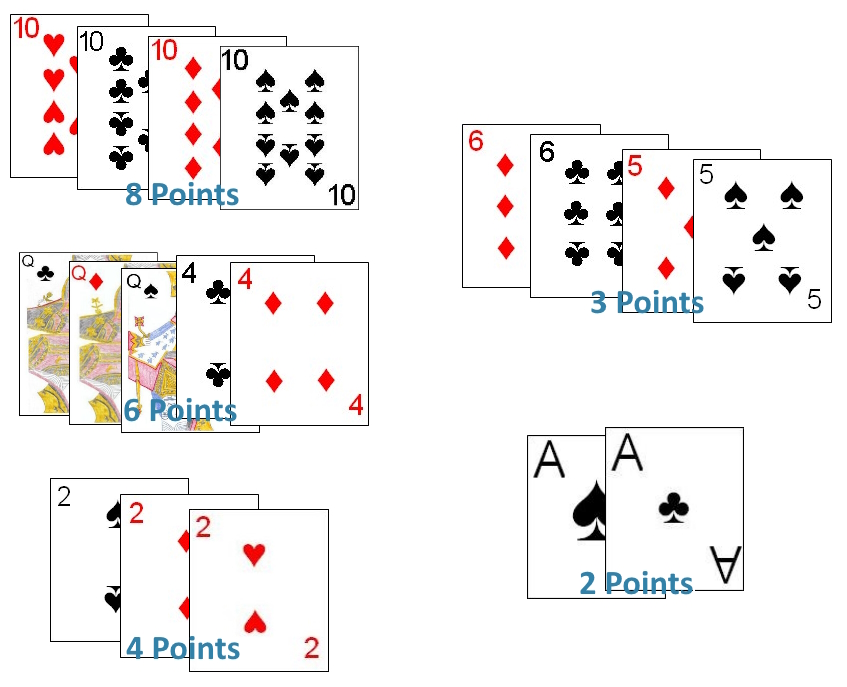 |
The winning player adds the appropriate number of points to his ongoing score. All the cards from the player's hands are then gathered together and simply added to the bottom of the stock.
The stock is not shuffled after each hand, with the next dealer in turn simply continuing to deal from the top of the deck. The game continues until one player, upon the completion of a hand, reaches or exceeds 20 total accumulated points.
Kitti: Kitti is a vying type game which is played in Nepal, and nearby areas of India. Kitti uses one standard 52 card deck and is designed for play by four players. The game is also played, in other locales under the name Nine Card Brag. The ranking of the cards as used in this game is as follows (from highest to lowest): Ace, King, Queen, Jack, 10, 9, 8, 7, 6, 5, 4, 3, 2, Ace. As will be noticed, an Ace can be either high or low. Normally the Ace is considered the highest ranked card. However, an Ace can also be used in low straight flushes,
which also contains a two and three. In those particular circumstances, the Ace is considered a low card, below the rank of the
deuce (two)|.
Determination of seating positions and first dealer can be performed using a variety of methods, with a draw from a shuffled, face-down deck a common such method. Using this method, the players would take their preferred seats at the table in the ranking order of cards as drawn, from highest to lowest. Any players drawing cards of equal rank would set those cards aside and draw replacement cards. The player drawing the highest card of all is set as the first dealer. After each hand, the role of dealer rotates around the table in a
counter-clockwise direction.
To begin each hand or game, the dealer deals out a total of nine cards to each player. These cards are dealt out one-by-one and face down, in a counter-clockwise direction around the table, starting with the player to the immediate left of the dealer.
After each player has been dealt their cards, that player then arranges his hand into three combinations of three cards each. He would thus form three partitions consisting of three cards. The player obviously attempts to form the best three card combinations as able. The following are the legal combinations used in this game and their relative ranking:
| Relative Ranking | Three Card Hand | Description | Example |
|---|
| 1 | 2 - 3 - 5 | One two, one three and one five, each in a different suit. | 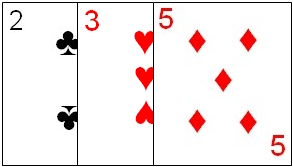 |
| 2 | Triple Cards | This is a combination consisting of three cards of the exact same rank. In comparing multiple three of a kind combinations, the hands are further be ranked by the denomination of the cards forming the triple. | 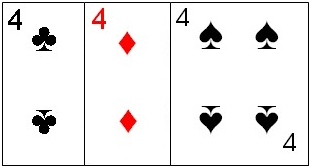 |
| 3 | Royal Flush | This hand consists of an Ace, King and Queen, all of the same suit. |  |
| 4 | Straight Flush | A straight flush consists of three cards, all in direct sequential ordering and all of the same suit. In comparing multiple straight flushes, the highest is considered the straight flush containing the highest cards. |  |
| 5 | Straight | This combination consists of three cards all in direct sequential order, but not necessarily all of the same suit. In comparing multiple such straights, the one containing the highest cards. | 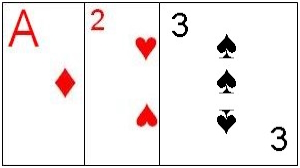 |
| 6 | Flush |
This combination consists of three all of the same suit, but not all in direct sequential order. In comparing multiple such flushes, the one containing the highest ranked card is considered the highest. |
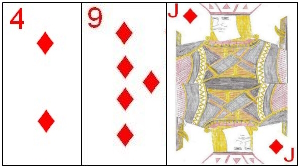 |
| 7 | Pair | This hand consists of two cards of the exact same denomination with a third card of any other denomination. In comparing two such similar hands, the higher hand is that containing a pair which consists of higher denomination cards. If the pairs are of the same rank, the hands are compared by whichever player has the highest non-matched card in that combination. | 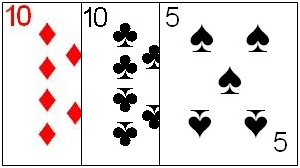 |
| 8 | High Card | This is a combination which has no matched cards and the cards are not all of the same suit and not in direct sequential order. This is the lowest available combination, and in comparing multiple combinations of this type, the highest is that which contains the highest ranked card within it. | 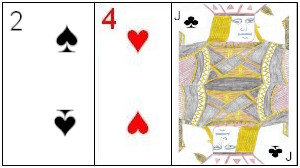 |
Once the players have thus formed their hand into three such combinations, they then perform the
"Show". In the "Show" each player first shows his highest ranked combination on the table. It is then noted which player has the highest ranked such combination. Next, each player then shows their second highest ranked three-card combination. It is again noted which player has the highest combination. Lastly, each player shows their lowest three card combination, and it is again noted who shows the highest such combination.
The final results of the game are then determined based on which players managed to have the highest ranked combination in each of the three comparisons performed. The potential results of the hand are as follows:
- Salami: This is the situation in which any one player managed to win all three comparisons. This player has thus won the game. This is also sometimes called a double win.
- Winner: If one player manages to win the first and second or second and third hands of the show, that player is also considered the winner of the game (single win).
- Kitti: In all other situations, such as a different player winning each hand, one player winning the first and third hand, or with no player winning more than one combination due to a tied combination (a "Drawn" hand), this ends in a "Kitti game" with no player having won the game, and another hand is immediately dealt by the next dealer in turn.
Once a game has been won, a new game can then be dealt, as there can often be a winner in every hand.
In addition to these winning conditions during the Show, if any player finds that he has four cards all of the same rank (such as four eights) after the deal, he immediately wins the current game which no Show taking place.
Additionally, if a player finds in his hand that he has four individual pairs of cards, he simply shows these, and the cards are thrown in with no show or scoring on that hand (in essence, a Kitti hand).
Crash: Crash is another vying type game in which players partition their original dealt cards into multiple, smaller hands. This game is known as Crackers in Scotland, and sometimes, in England, as Thirteen Card Brag.
This game is designed for two to four players, using one standard 52 card deck. The ranking of the cards in this deck are as follows (from high to low): Ace, King, Queen, Jack, 10, 9, 8, 7, 6, 5, 4, 3, 2.
Determination of seating positions and first dealer can be performed in any variety of ways with draw for high cards a common method. Using that methods, each player would draw one card from the shuffled deck and take their precedence of seats in order of cards drawn from highest to lowest. The player drawing the highest card of all is set as the first dealer.
The dealer begins by thoroughly shuffling the cards and offering it to the player at his right to cut. After the cut, he begins dealing the cards, one by one and face-down, starting with the player at his immediate right. He continues dealing in a clockwise rotation around the table until each player has a total of 13 cards. If there are any cards remaining, these cards are set aside, out of play for the remainder of that hand.
After the deal, each player than picks up their cards and attempts to form these cards into four smaller hands consisting of three cards each. The goal, as in most other games of this type, is to form the highest such hands. The following shows the ranking of the possible hands recognized in this game
listed from highest to lowest:
| Ranking | Name | Description | Example Combination |
|---|
| 1 | Threes Prial | This is the highest ranked hand in this game and cannot be
beaten by any other hand. This hand consists of a combination of three cards of rank 3. | 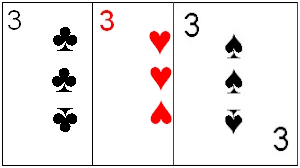 |
| 2 | Prial | A standard prial is the next highest ranked hand type in the game. This is a combination of three cards of the exact same rank. If comparing multiple such prials, these are further ranked by the ranking of the cards comprising the prial. |  |
| 3 | Running Flush | This combination consists of three cards, all in the same suit, and in direct
sequential order. If comparing multiple combinations of this type, the highest is that which contains the higher cards. If all cards in the combination are of the same type, those hands would be tied. | 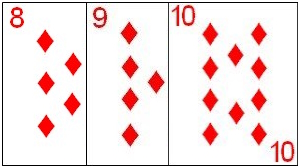 |
| 4 | Run | This is a combination which consists of three cards in direct sequential order but which are not all in the same suit. In comparing multiple Runs, the run containing the highest cards is considered the highest ranked. If the highest such Runs have all cards of the same rank, these Runs are considered a tie. | 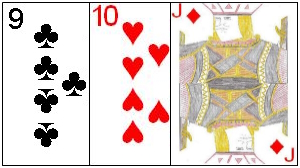 |
| 5 | Flush | A Flush is a combination of three cards all of the same suit, but not in direct sequential order. If comparing multiple such flushes, these can be further ranked based on which contains the higher cards. If every card in the compared flushes is exactly identical, the hands are considered tied. | 
|
| 6 | Pair | A pair is a three card combination consisting of two cards of the exact same rank, and a third card of any other rank. If comparing two
"Pair" combinations, the combination consisting of a higher pair is considered the higher rank. If the combinations are each of equally ranked cards, the rank of the third card in the combination is used to determine rank. If this card is also of the same rank in the hands, the hands are
considered to be tied. | 
|
| 7 | High Card | This is a hand which consists of none of the other recognized combinations, and is basically three cards which are not all of the same suit, not of the same rank, and are not in direct sequential order. If comparing two such hands, the combination containing the highest cards is considered the higher. If every card in the combinations is exactly equal in rank, the combinations are considered a tie. | 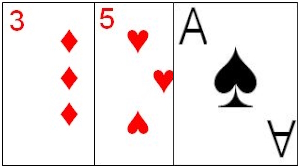
|
The players will thus form their hand into four three card hands, with one card left over, which is not used for the remainder of the hand. After the players have had the opportunity to so arrange their hands, play of the hand begins, which will consist of a series of comparisons of the three card hands from highest to lowest. To start, each player must then show their highest formed three card combination to the table. Whichever player has the highest ranked combination scores one point. If the two highest combinations are exactly tied, no one scores the point for that combination (this is called a "stick-up" or "stopper").
Next, each player then shows their second highest hand, and whichever player shows the highest such hand also scores one point. The players then show their third highest, and then, finally, compare their fourth and last highest hands.
If one player manages to win all four points during the hand (called "crash") that player immediately wins the entire game.
There are a few special combinations which are also sometimes recognized in this game. If a player finds that he is initially dealt four cards all of the same rank, he immediately scores one point for this. However, if there are two or more players who have been dealt such a hand, only the highest such hand scores the extra point. A four of a kind consisting of four fours is considered the highest, followed by four Aces, down to twos. If a player finds his hand can be formed into one continuous sequence of cards, from two up to Ace, that player immediately wins the entire game. If a player finds that his hand consists of six pairs of cards, that player may (but is not required to), announce this, show the hand, and the hand is not played, with the cards gathered up, shuffled, and a new hand dealt. If any players shows a lower hand before a higher hand during the comparisons in a particular hand, this is called a foul, and that player must drop from the game, with the remaining players continuing to determine a winner.
The game continues over a series of hands until one player manages to earn seven or more points after scoring on a hand. If multiple players so manage this, the player with the highest score is declared the game winner.
In many games, the "Pair" and "High card" combinations are not recognized as legal combinations. In those cases, if a player cannot form a higher hand, he does not participate in that particular comparison (and puts the remainder of his cards aside and out of play).
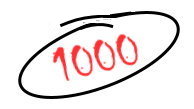
 Hazari is a vying or comparing game which is commonly played in Bangladesh and other surrounding areas (such as Bhutan). Hazari (which translates to "1000") also commonly goes by the name "1000 Points" which describes the number of points a player is required to score in order to be victorious.
Hazari is a vying or comparing game which is commonly played in Bangladesh and other surrounding areas (such as Bhutan). Hazari (which translates to "1000") also commonly goes by the name "1000 Points" which describes the number of points a player is required to score in order to be victorious.
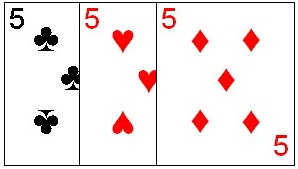
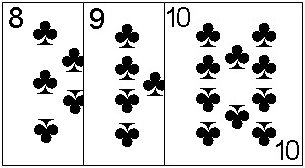
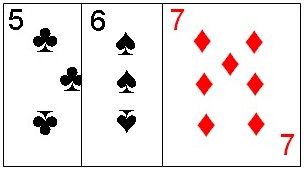
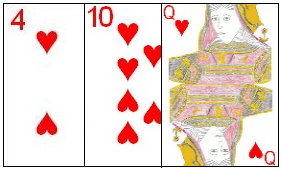
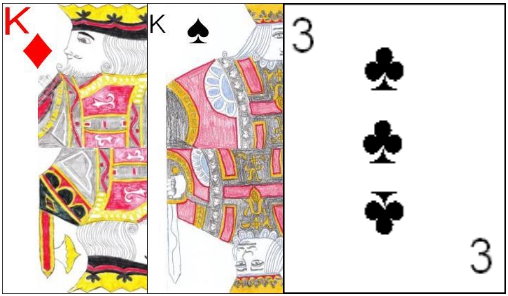

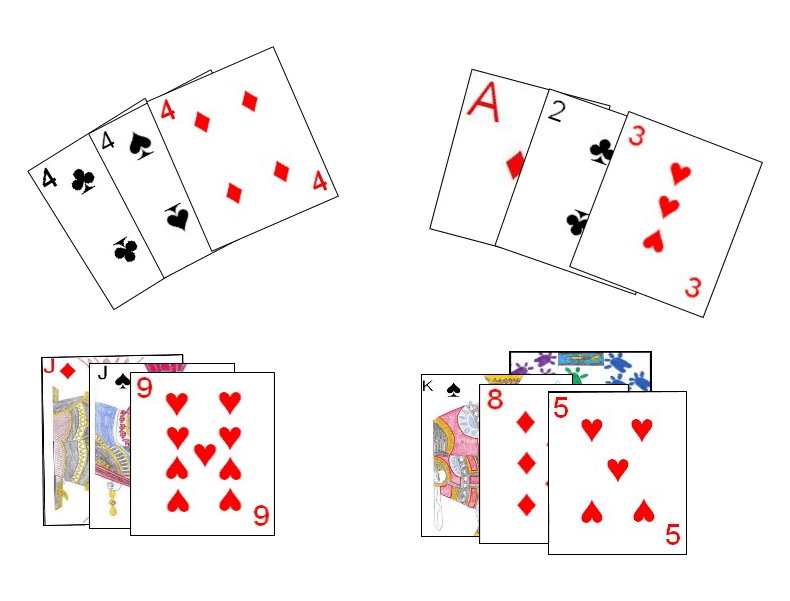 After each player has the opportunity to create the four arrangements of face-down combinations of cards, the player would then arrange these combinations in front of himself, from the highest to the lowest. The combination containing the extra, fourth card, should be the lowest ranked card of the four the player has created. Once a player is satisfied with his combinations, he states "Up", indicating he is ready to move to the next phase of the game. Once stating this, however, a player may no longer re-arrange his combinations as he has set. After all four players have stated "Up", the next phase of the hand begins.
After each player has the opportunity to create the four arrangements of face-down combinations of cards, the player would then arrange these combinations in front of himself, from the highest to the lowest. The combination containing the extra, fourth card, should be the lowest ranked card of the four the player has created. Once a player is satisfied with his combinations, he states "Up", indicating he is ready to move to the next phase of the game. Once stating this, however, a player may no longer re-arrange his combinations as he has set. After all four players have stated "Up", the next phase of the hand begins.















